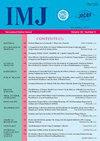青年头前位患者颈部定位肌筋膜疼痛综合征的特点
Q4 Medicine
引用次数: 0
摘要
非特异性肌肉疼痛最常见的变体之一是肌筋膜疼痛。为了解年轻前倾头位患者颈椎定位肌筋膜疼痛综合征的特点及其对日常生活的影响,对37例患者进行了检查。进行临床-神经学、椎体-神经学检查(静态障碍的视觉诊断、手工诊断、肌肉的动觉检查)、颅椎角的摄影测量、颈部疼痛的视觉模拟量表评估及其对患者的影响。所有患者的视觉诊断均显示颈椎水平区域重心前移,形成头部前倾姿势,通过测量颅椎角值- 48.3±1.56°证实。之间存在着负相关的价值craniovertebral角度和疼痛量表的评估(r =−0.91,p < 0.05),以及之间的价值craniovertebral角度和颈部疼痛的重要障碍指数(r =−0.93,p < 0.05),这表明前转的影响区域重心cervicalgia的严重程度和它对日常生活的影响程度的年轻患者。根据研究结果,得出结论。年轻头前位患者肌筋膜颈痛综合征的特点是与中性头位患者相比,参与病理过程的肌群数量更多,头颈伸肌缩短,并形成活动触发点,颈部疼痛的严重程度更大,颈痛对日常生活的负面影响更大。关键词:头部前倾,肌筋膜疼痛综合征,触发点,颈痛。本文章由计算机程序翻译,如有差异,请以英文原文为准。
FEATURES OF MYOFASCIAL PAIN SYNDROME OF CERVICAL LOCALIZATION IN YOUNG PATIENTS WITH FORWARD HEAD POSTURE
One of the most common variants of non−specific muscle pain is myofascial one. To establish the features of myofascial pain syndrome of cervical localization and its impact on daily life in young patients withforward head posture, 37 patients were examined. There were performed clinical−neurological, vertebro−neurological examination (visual diagnosis of static disorders, manual diagnosis, kinesthetic examination of muscles), photogrammetric measurement of craniovertebral angle, assessment of neck pain on a visual analog scale and its impact on patients. In all patients a visual diagnosis revealed a shift of regional center of gravity at the cervical level forward with the formation of the head forward posrture, which was confirmed by measuring the value of the craniovertebral angle − 48.3±1.56 °. There was a negative correlation between the value of craniovertebral angle and assessment of pain on a scale (r = −0.91, p < 0.05), as well as between the value of craniovertebral angle and index of vital disorders in neck pain (r = −0.93, p < 0.05), which indicates the effect of forward shifting the regional center of gravity on the severity of cervicalgia and the degree of its impact on the daily lives of young patients. Based on the results of the study, conclusions were drawn. Myofascial cervical pain syndrome in young patients with head forward posture is characterized with a bigger number of muscle groups involved into the pathological process with shortening of the head and neck extensor muscles as well as the formation of active trigger points, greater severity of neck pain and the negative impact of cervicalgia on daily life compared to the patients with a neutral head posture.
Key words: forward head posture, myofascial pain syndrome, trigger point, cervicalgia.
求助全文
通过发布文献求助,成功后即可免费获取论文全文。
去求助
来源期刊

International Medical Journal
医学-医学:内科
自引率
0.00%
发文量
21
审稿时长
4-8 weeks
期刊介绍:
The International Medical Journal is intended to provide a multidisciplinary forum for the exchange of ideas and information among professionals concerned with medicine and related disciplines in the world. It is recognized that many other disciplines have an important contribution to make in furthering knowledge of the physical life and mental life and the Editors welcome relevant contributions from them.
The Editors and Publishers wish to encourage a dialogue among the experts from different countries whose diverse cultures afford interesting and challenging alternatives to existing theories and practices. Priority will therefore be given to articles which are oriented to an international perspective. The journal will publish reviews of high quality on contemporary issues, significant clinical studies, and conceptual contributions, as well as serve in the rapid dissemination of important and relevant research findings.
The International Medical Journal (IMJ) was first established in 1994.
 求助内容:
求助内容: 应助结果提醒方式:
应助结果提醒方式:


